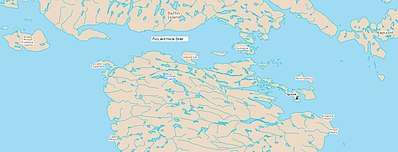Fury and Hecla Strait
Fury and Hecla Strait is a narrow (from 2 to 20 km (1.2 to 12.4 mi) wide) Arctic seawater channel located in the Qikiqtaaluk Region of Nunavut, Canada. Situated between Baffin Island to the north and the Melville Peninsula to the south, it connects Foxe Basin on the east with the Gulf of Boothia on the west. Water flow in the strait is sometimes westerly and sometimes easterly - there are diurnal and semidiurnal components to the flows; tidal and subtidal effects also play a role. The strait provides Arctic Ocean drainage for Hudson Bay via Foxe Basin.

The Strait is named after the Royal Navy ships HMS Fury and HMS Hecla, which encountered the strait in 1822 during an expedition led by Sir William Edward Parry. Both ships became stuck in ice in October 1821, and remained immobile for eight months. During this time, the expedition learned of the strait from the native Inuit. Two men from the expedition set out with four Inuit on sled to assess the strait. Captain Parry would later accompany another trip to the strait.[1]
In 1948, USS Edisto and USCGC Eastwind succeeded in crossing the strait from east to west, and HMCS Labrador succeeded in crossing the strait from west to east in 1956.[2]
- The Ping, described as "acoustic anomalies" whose "sound[s] scare sea animals". It is heard in the Fury and Hecla Strait. It is being investigated by Canadian military authorities.[3]
In August 2016, David Scott Cowper and son, Freddy Cowper, aboard M/V Polar Bound became the first vessel to transit Fury and Hecla Strait from east to west during their successful Route-7 West Northwest Passage.[4]
See also
- List of unidentified sounds
References
- (Ross 1960)
- (Ross 1960)
- Canadian military investigating mysterious 'ping' sound scaring sea animals
- Pohl, Douglas (2016-12-18). "Northwest Passage Route-7 Transits as of the end of 2016". arcticnorthwestpassage.blogspot.com. Blogger (Google). Retrieved 2019-01-14.
Who has completed a Route-7 Northwest Passage since Fury & Hecla Strait was discovered in 1822 by William Edward Parry? Chronological List: (Only five vessels) (Date, Vessel, Route & Direction of Transit) 1. 1970, R/V PANDORA II, Route-7 East; 2. 1970, R/V THETA, Route-7 East; 3. 2006, 24,200hp Icebreaker KAPITAN KHLEBNIKOV, Route-7 East; 4. 20160826, M/V POLAR BOUND, Route-7 West;
Works Cited
- Ross, W. Gillies (1960-02-02), "Parry's Second Voyage", History Today, 10 (2), retrieved 2019-01-13
- Pearson, Jordan (2017-02-24). "The Army Sent a Lone Specialist to the Arctic to Investigate a Mysterious Ping". motherboard.vice.com. Vice Media. Retrieved 2019-01-13.
Further reading
- Chandler, F. W. Geology of the Late Precambrian Fury and Hecla Group, Northwest Baffin Island, District of Franklin. Ottawa, Canada: Energy, Mines and Resources Canada, 1988. ISBN 0-660-12652-4
- Ciesielski, A. The Basement to the Fury & Hecla Group Lithologic, Structural and Geochemical Data, Northwest Baffin Island. Ottawa, Ont: Geological Survey of Canada, 1992.
- Hall, Charles Francis, and J. E. Nourse. Narrative of the Second Arctic Expedition Made by Charles F. Hall His Voyage to Repulse Bay, Sledge Journeys to the Straits of Fury and Hecla and to King William's Land, and Residence Among the Eskimos, During the Years 1864-'69. Washington: G.P.O., 1879.
- Lee, Geoffrey. Note on Arctic Palaeozioc Fossils from the "Hecla" and "Fury" Collections. 1912.